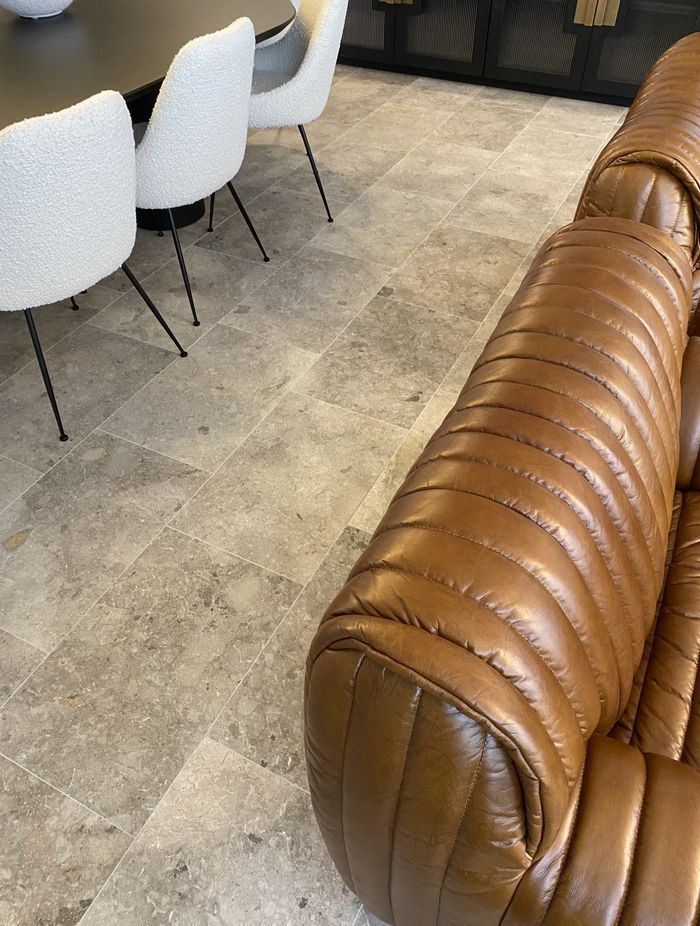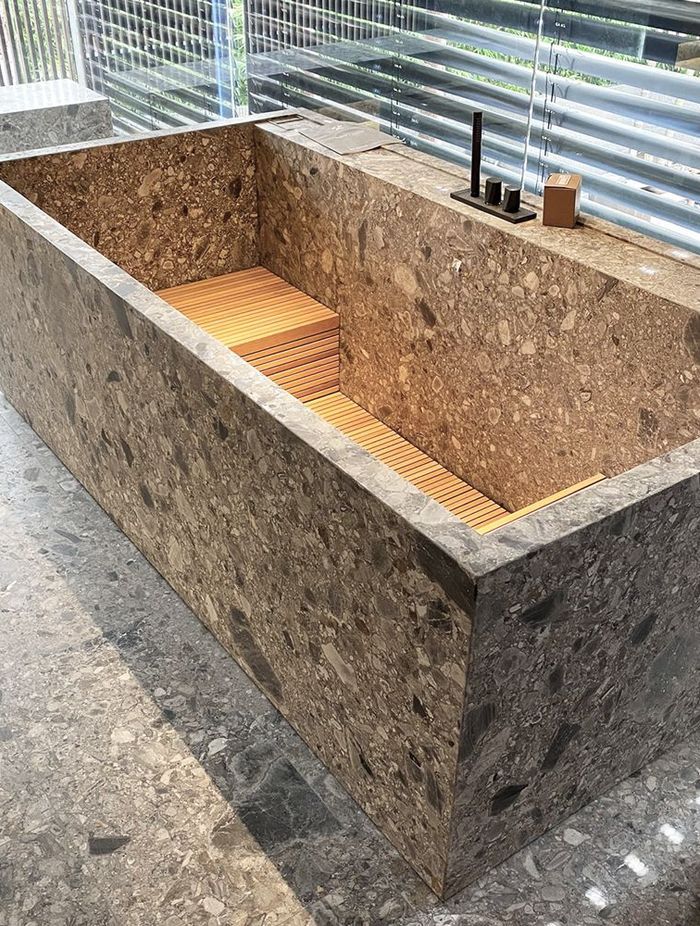Natural stone: A guide to types, applications and more

There are many different forms of natural stone that make fantastic materials for a wide range of interior and exterior features. In this guide, we take a look at what these forms are, their advantages, and the common applications they are used for.
What is natural stone?
Natural stone refers to a variety of minerals and rocks that are quarried from the earth and used in construction, decoration, and sculpture. These materials are extracted in their natural form from the earth's surface or from mines. Natural stone encompasses a wide range of rock types, including sedimentary stones (such as limestone and sandstone), igneous stones (like granite and basalt), and metamorphic stones (including marble and slate), among others. Each type has unique characteristics in terms of appearance, texture, durability, and porosity, which determine its suitability for different applications.
The key attributes that define natural stone include its geological formation, mineral composition, and the natural processes that have shaped it over thousands or even millions of years. Unlike manufactured or engineered stone products, natural stone retains the unique colours, patterns, and textures that are created by nature. The natural stone market continues to expand and is estimated to reach $57.6 billion in total value by 2032, which goes to show just how popular natural stones are.
Types of natural stone
Some of the most common types of natural stone are:
Granite
Known for its hardness and longevity, granite is a popular choice for countertops, flooring, and outdoor applications. It's formed from the slow crystallisation of magma below Earth's surface and features a granular appearance.
Marble
Valued for its natural beauty and essence, marble is a metamorphic rock that forms when limestone is subjected to high pressure and temperature. Its distinctive veining and wide range of colours make it a favourite for bathroom vanities, flooring, and decorative elements.
Limestone
Composed mainly of calcite, limestone is a sedimentary rock that forms in marine environments. It's used in construction, for flooring, wall cladding, and in the manufacture of lime and cement.
Slate
Slate is a fine-grained metamorphic rock derived from shale. Known for its durability and slip resistance, it is used in roofing, flooring, and outdoor paving.
Sandstone
This sedimentary rock is composed of sand-sized mineral particles or rock fragments. With its range of colours, sandstone is commonly used for exterior facades, walls, and landscaping projects.
Quartzite
Formed from sandstone and quartz, quartzite is a hard, metamorphic rock. It's highly resistant to wear and tear, making it suitable for countertops and flooring.
Travertine
A form of limestone deposited by mineral springs, travertine has a fibrous, marble-like texture. It's used for facades, wall cladding, and flooring, especially in bathrooms and kitchens.
Onyx
Onyx is a banded variety of chalcedony, a mineral. With its translucent quality and striking bands of colour, onyx is often used for decorative items, lighting fixtures, and as a material for countertops and wall cladding.
Soapstone
Composed primarily of talc, soapstone is known for its softness. It's resistant to heat, making it a popular choice for kitchen counter and bench tops and sinks, as well as stoves.
Basalt
Basalt is a dark-coloured, fine-grained igneous rock. Due to its durability and resistance to weathering, it's often used in construction, as paving stones, and in landscaping.
Related article: 10 popular types of cladding in Australia
Pros of natural stone
Different natural stones have a multitude of benefits in common:
Longevity
Natural stone is incredibly durable and can last for centuries if properly maintained. It is capable of withstanding severe weather conditions, heavy traffic, and the wear and tear of daily use.
Unique character
No two pieces of natural stone are exactly the same. This uniqueness allows for the creation of distinctive and personalised spaces.
Adds value to property
Incorporating natural stone into a property can significantly increase its value. Its aesthetic appeal and durability make it a desirable feature for potential buyers.
Low maintenance
Once installed and sealed correctly, natural stone requires relatively low maintenance to keep it looking its best. Simple cleaning and occasional sealing are usually sufficient.
Versatility
Natural stone can be used in various applications, from flooring and wall cladding to countertops and decorative features. It suits different styles, from rustic to modern.
Natural insulator
Stone has natural insulating properties, helping to maintain consistent indoor temperatures. It can keep spaces cooler in the summer and warmer in the winter.
Fire resistance
Unlike many synthetic materials, natural stone is fire-resistant, making it a safe choice for fireplaces, exterior walls, and other areas exposed to high temperatures.
Related article: 12 kitchen benchtop materials to consider in 2024
Cons of natural stone
Cost
While natural stone can add value to a property, its initial acquisition and installation costs can be higher than those of other materials. This is due to the quarrying, cutting, and transportation of the stone, as well as the specialised labour required for its installation.
Weight
Natural stone's durability and longevity come with the trade-off of it being quite heavy. This can limit its application in certain environments without proper structural support, leading to additional costs or engineering considerations.
Availability
Depending on the type of stone and its origin, there can be limitations on availability. Some stones are quarried in specific parts of the world, which might affect lead times and availability for your project.
Installation challenges
The installation of natural stone requires skilled craftsmanship, and errors can be costly to rectify. The process can be more time-consuming and complex compared to installing manufactured materials.
Natural stone applications
Flooring
Natural stone flooring is a popular flooring choice. The wide range of natural stones available means homeowners can create a desirable floor that fits their own style. Granite, marble and limestone are all popular choices, particularly in bathrooms and kitchens.
Wall cladding
Natural stone is a popular cladding material wall cladding choice. Materials such as limestone, sandstone, bluestone and granite. The raw, natural beauty these stones offer make it popular in coastal areas, and homes built to fit a traditional, historical style. Natural stone can be used on the exterior and interior of a home.
Countertops and work surfaces
Natural stones are often used for countertops in kitchens and bathrooms because of their longevity, resistance to scratches and heat and unique designs. Granite and marble are popular choices.
Landscaping
In landscaping, natural stone is used for pathways, patios, garden steps, and retaining walls due to its ability to blend with natural surroundings
Architectural features
Stone can be used to create unique architectural features such as fireplaces, fountains, and archways. Natural stones can also be cut and shaped to fit specific design requirements, allowing for custom applications.
Monuments and sculptures
The use of natural stone in monuments and sculptures is age-old. Artists and sculptors choose specific types of stone for their texture, colour, and workability.
Related article: 13 stunning interior wall cladding ideas to inspire you
Understanding natural stone
This guide should have provided you with a solid foundational understanding of the various types of natural stone available. Most natural stones can be utilized for a wide range of indoor and outdoor applications. Regardless of the stone you choose, it should endure for many years and add a touch of elegance to your home.
Browse a range of different natural stone options from Australia's top suppliers on ArchiPro






